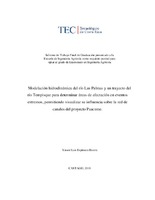| dc.contributor.advisor | Watson-Hernández, Fernando | es |
| dc.contributor.author | Espinoza-Rivera, Yasser Luis | |
| dc.date.accessioned | 2020-03-27T16:00:40Z | |
| dc.date.available | 2020-03-27T16:00:40Z | |
| dc.date.issued | 2018 | |
| dc.identifier.uri | https://hdl.handle.net/2238/11288 | |
| dc.description | Proyecto de Graduación (Licenciatura en Ingeniería Agrícola) Instituto Tecnológico de Costa Rica, Escuela de Ingeniería Agrícola, 2018. | es |
| dc.description.abstract | En este proyecto se analizó el comportamiento hidrodinámico del río Las Palmas y un trayecto del río Tempisque en la provincia de Guanacaste, ya que es de interés para el Senara contar con un estudio técnico, donde se demuestre el impacto de las inundaciones ocasionadas por el desbordamiento de los ríos antes mencionados y así determinar que secciones de la red de canales del proyecto Paacume podrían ser afectadas.
Como principal escenario se planteó recrear las manchas de inundación que generó la tormenta Nate, que afectó al país los días 4 y 5 de octubre del 2017; para esto fue necesario recolectar información que se registró durante la tormenta.
Se realizó un modelo matemático para generar de forma indirecta la ecuación que relaciona tirante con caudal y así elaborar el hidrograma que originó la tormenta en el río Tempisque. Los hidrogramas de los afluentes del río Las Palmas se obtuvieron a partir de los registros de las estaciones meteorológicas ubicadas en La Guinea, Aeropuerto Liberia y El Corral. Como método de pérdidas se usó el método de Número de Curva y para transformación de precipitaciones a caudales se usó el método de Hidrograma Unitario, ambos métodos desarrollados por el Servicio de Conservación de Suelos de los Estados Unidos (SCS).
El modelo hidrodinámico se realizó con el programa Iber 2.3.2 y de las pruebas realizadas se obtuvo que para una condición hidrológica 2 (CHA 2), el comportamiento de las manchas de inundación y sus niveles eran similares a los registrados durante la tormenta, por lo que en este documento solo se analizaron los resultados del modelo hidrodinámico. | es |
| dc.description.abstract | This study analyzed Las Palmas river’s hydrodynamic behavior, and also a section of the Tempisque river in Guanacaste - which is one of the provinces of Costa Rica- because the value of this technical study helps Senara to show the impact of the floods caused by the overflowing of the aforementioned rivers. As a result, this analysis can determine what sections of the Paacume project waterways could be affected. Based on the collected data from Tropical storm Nate, the outlined scenario was to recreate the spots of the flood caused by Tropical Storm which affected Costa Rica in October 4th and 5th, 2017. The registered data pertained only to the levels Tempisque river reached in the bridge located in the community of Guardia; therefore, a math model was implemented in order to obtain the hydrograph that the storm could produce. Las Palmas river’s tributaries hydrographs were based on the data from the weather stations located in La Guinea, Liberia Airport, and El Corral. The runoff curve number was the parameter used for this study. The hydrodynamic model was carried out in Iber 2.3.2, and after testing, the outcome was that a hydrologic condition (CHA 2) showed that the behavior of the flood spots and its levels were similar to the ones registered during the tropical storm; hence, this work will emphasize the hydrodynamic model achieved from a hydrologic condition. | es |
| dc.language.iso | spa | es |
| dc.publisher | Instituto Tecnológico de Costa Rica | es |
| dc.subject | Hidrodinámica | es |
| dc.subject | Inundación | es |
| dc.subject | Hydrodynamics | es |
| dc.subject | Floods | es |
| dc.subject | Research Subject Categories::FORESTRY, AGRICULTURAL SCIENCES and LANDSCAPE PLANNING::Area technology::Agricultural engineering | es |
| dc.subject | Estudio técnico | es |
| dc.subject | Modelado matemático | es |
| dc.subject | Canales hidráulicos | es |
| dc.subject | Hydraulic channel | es |
| dc.subject | Technical study | es |
| dc.subject | Mathematical modeling | es |
| dc.title | Modelación hidrodinámica del río Las Palmas y un trayecto del río Tempisque para determinar áreas de afectación en eventos extremos, permitiendo visualizar su influencia sobre la red de canales del proyecto Paacume | es |
| dc.type | licentiateThesis | es |


